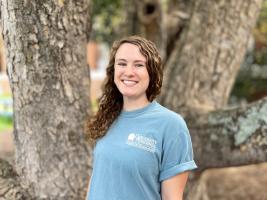
University of Virginia Engineering student Jessica Besnier is collaborating with NASA climatologists to understand South America’s second largest river and its recent historical drought that grounded ships and dried-up spigots throughout the region.
The Parana River’s 77-year-low water levels in Paraguay, Argentina and Brazil began in 2019. The drought subsided in 2021, the year Besnier, a Ph.D. candidate in the Civil and Engineering Department, arrived at UVA.
The hydrologist has since trained her attention on those who were worst hit by the drought, the estimated 100 million people living along the river’s lower end, at the La Plata River Basin. She knows they’ll have some planning to do – water and crop management – to avoid deprivation in the future.
“My main goal is to help people around the world gain access to basic needs,” she said, “especially in times of disaster.”

Finding Her Focus
Before she officially started her course work, though, Besnier wasn’t sure exactly where her research focus would lie.
“I had no idea about remote sensing hydrology or any idea of what regions or topics I wanted to work on,” she said.
But her adviser, professor Venkataraman Lakshmi, gave her a preliminary assignment that summer: Submit an abstract for the American Geophysical Union’s fall meeting on something you may wish to research further.
“So, after some conversations and some googling and reading of articles, I decided to find a natural disaster that happened somewhere Spanish-speaking, as I minored in Spanish as an undergrad,” she said.
“That narrowed it down to natural disasters in Central and South America. From there, I found articles and decided to study the drought event in La Plata River Basin.”

From Access to Success
UVA connected Besnier with two NASA hydrologists, Augusto Getirana and Hiroko Beaudoing, who have at their fingertips some of the best satellite-based resources in the world at the Goddard Space Flight Center.
Now, she’s author with those two experts and Lakshmi on her first published paper as first author. The Journal of Hydrology: Regional Studies featured the article in its April edition.
The research is first to use high-resolution moisture data to understand the drought’s footprint over space and time.
The team’s findings confirmed previous assertions about the drought’s progression and discovered that the Upper Parana subbasin lost the most water throughout the period.
Besnier is a Richmond native who earned her undergraduate degree from James Madison University.
“This was my first project I worked on in my Ph.D. journey, and I was so surprised by the number of datasets, resources and training available to the public and to me in grad school,” Besnier said.